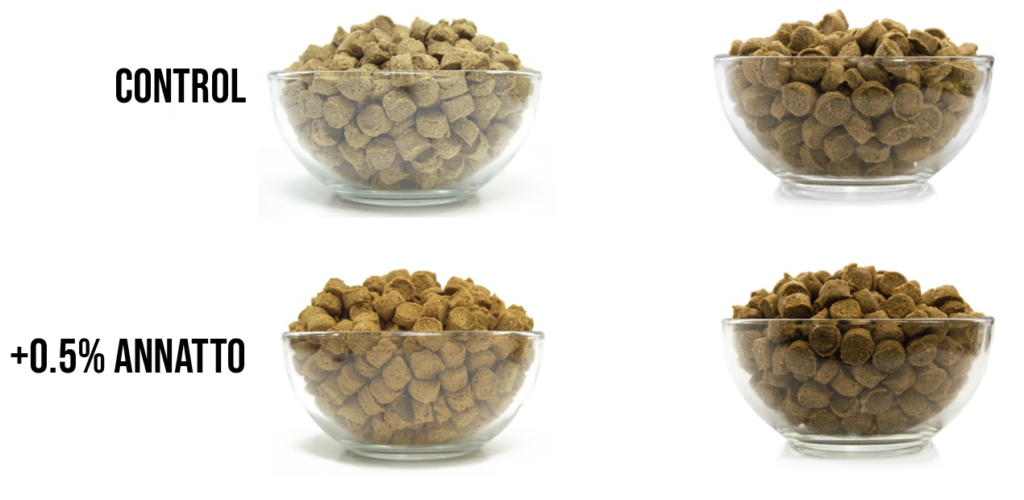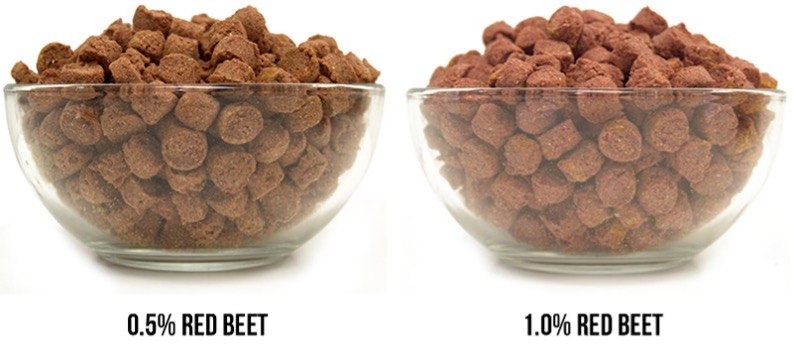These days, we treat our pets like family – and that extends to the food and treats we give them. Consumers are increasingly interested in knowing the ingredients in their pets’ food, presenting a great opportunity to use natural colors. However, there are some important factors your should consider when choosing a natural color for your product. We’ve broken down the top 5 considerations when coloring pet food applications.
1. Pet Friendly Ingredients
The most important factor we consider when formulating for pet food is safety. Colors that are safe for pet consumption are not always the same as those for human consumption. For example, it’s important to use colors formulated without propylene glycol for cat food applications while dog and cat foods need to be formulated without ingredients that include onions, garlic, and grapes/raisins.
We are very careful when formulating our blends for pet food to make sure they’re safe for pets. But if you have any additional ingredients that you prefer not to include, be sure to let us know early in the process so we can get you the right color as quickly as possible.
2. Flavor/Target Color
We all know our pets don’t really care about the color of the food, but having a color that matches the flavor on the bag is still important for the pet owners. Since some pets are picky eaters or can develop allergies to certain animal proteins, the color of the pet food helps distinguish flavors so they ensure they bought the right kind.
The first step to selecting the right color is to set a target color for the pet food or treat that matches the flavor profile consumers are expecting. You might choose a deep brown hue for beef flavors, yellow for a chicken or turkey, or an orange to pink hue for salmon.
There are many color options available for extruded kibbles to match with different flavors, including color blends. For a chicken or turkey flavor, you could use a blend of caramel and beta-carotene or annatto to produce a range of yellow hues. Caramel color is a good option for a beef or lamb flavor, and beet or carmine can be used for a salmon flavor depending on your labeling requirements and processing conditions.
Each flavor requires specific colors and dosage rates. But, if a beef flavored food looks yellow or orange, that could create a lot of confusion for the pet owner. They might think they picked up the wrong flavor or that there’s a quality issue with the product.

3. Base Color
As seen in the image below, the base color can have a huge impact on the final color of your product. Bases that contain more grains tend to be lighter and bases that contain more protein (like chicken meal) are typically darker. This can significantly change how the final color is perceived.

When formulating with natural colors, it’s important to remember that the darker the base color, the higher the dosage rate you may need to use to overcome the darker base tones. You may need to use a lighter colored base if you want to show certain flavors or if you have dosage rate limitations in your formula.
However, different base colors can also help create variety in a kibble or snack blend if several bases are utilized for different flavors. You could theoretically use the same dose of the same color in two different bases and get two entirely different looks.
4. Labeling
Deciding which claims and ingredients you want listed on the label is an important decision that is typically made early in product development. Different natural color products can carry different certifications, such as Certified Organic and non-GMO project verified, to match your ingredient claims. Since we have a variety of natural colors from different sources and manufacturing methods in our portfolio, understanding your labeling needs up front helps us narrow down the available colors to those that fit your development needs.
5. Processing Conditions
Extrusion and retort processing are probably the most common processing methods for pet foods – both of which can be hard on natural colors. But that doesn’t mean there aren’t solutions. Colors with high heat stability, such as caramels, carmine, annatto, and beta-carotene, are popular choices because they can withstand the intense heat during processing.
If the color has lower heat stability, you may need to increase the dosage rate based on the processing conditions. Dosage rate is important to consider in terms of heat processing, especially when you’re trying to replace synthetics or iron oxides since these colors typically have a very high heat stability and can survive both extrusion and retort. Natural colors may need to be overdosed a bit to overcompensate for any color loss during the manufacturing process. One example of this can be seen with red beet in the image below. Beet tends to brown or fade when heated is applied, such as through extrusion, baking, or retort. The amount of overdosing required to get a more red shade after processing will vary based on original dosage, the temperatures used in the process, and the time exposed to heat.
The best way to get the right color with your process is to share as much information as you can about processing times and temperatures, cool down times, drying times/methods, or extrusion so we can pick out a color or blend that can survive your manufacturing.

Choosing the right natural color for your pet food application can be challenging, but we’re here to help you find the right one that furry friends everywhere will love. Have questions? Contact us to get started on your next project.
